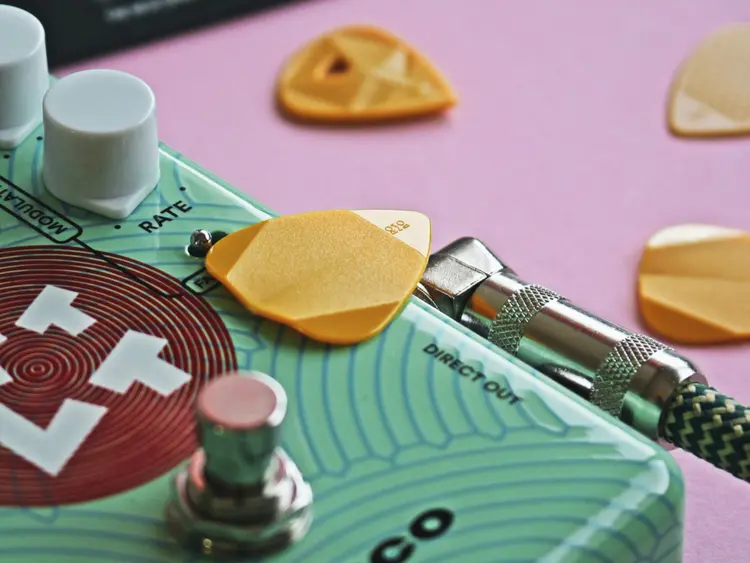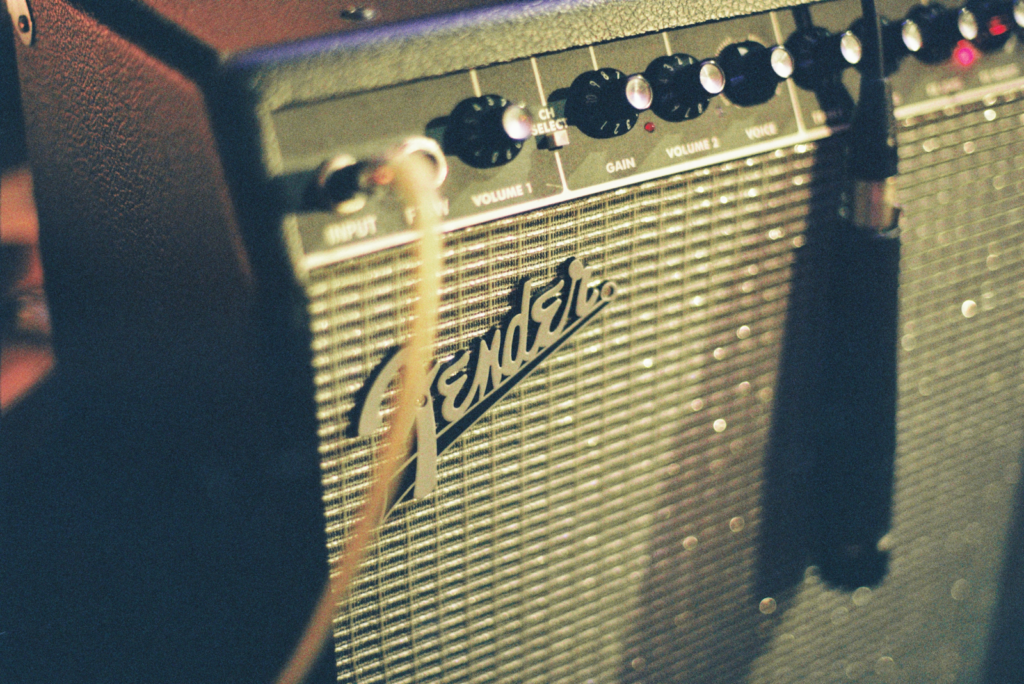Billy Gibbons, the iconic guitarist of ZZ Top, is not just a master of blues-rock but also a connoisseur of some of the most coveted guitars in the world. His collection, widely known in the guitar world, features a range of unique and historically significant instruments. This article delves into the legendary Billy Gibbons guitars, highlighting his exquisite taste and the stories behind these iconic axes.

[Source: https://www.flickr.com/photos/pixelillo/18989495551/]
Billy Gibbons: The Revered Guitarist of ZZ Top
For those new to the world of rock and blues, Billy Gibbons stands as a towering figure, renowned for his exceptional guitar skills and distinctive sound. With years of playing guitar behind him, Gibbons has cemented his place as one of the most influential guitarists in the history of rock music.
Billy Gibbons’ journey in music began in Houston, Texas, where he was born and raised. He quickly developed a deep passion for the guitar, drawing inspiration from blues and rock ‘n’ roll legends. His unique style, characterized by its bluesy roots and hard-rocking edge, led to the formation of ZZ Top in the late 1960s. Alongside bassist Dusty Hill and drummer Frank Beard, Gibbons propelled the band to international fame with hits like La Grange, Tush, and Sharp Dressed Man.
Gibbons is renowned not just for his technical prowess but also for his signature sound, which blends gritty Texas blues with hard rock. He is a master of tone, known for his use of different guitars and customized equipment to create sounds that are both powerful and soulful. His playing style, characterized by its economy and precision, has inspired generations of guitarists.
More Than Just a Musician
Beyond his musical achievements, Billy Gibbons is also known for his distinctive appearance, often sporting sunglasses, a hat, and a long beard, making him an iconic figure in the rock world. His deep knowledge of music, combined with his charismatic persona, has made him not just a musician but a cultural icon.
In summary, Billy Gibbons is a musician who epitomizes the spirit of rock and blues. His contribution to music goes beyond just his songs; it’s about a legacy that has inspired countless musicians and fans around the globe. For anyone delving into the realms of rock and blues, understanding and appreciating the artistry of Billy Gibbons is essential.
The Iconic “Pearly Gates” Les Paul
One of the most famous out of all his guitars is the Gibson Les Paul Standard, affectionately nicknamed “Pearly Gates.” This isn’t just any Les Paul; it’s a 1959 model, often revered as The Holy Grail of Les Pauls.
The story of how Billy acquired Pearly Gates is as legendary as the guitar itself.
Originally owned by a rancher from Downey, Texas, who had a history in a country band, the guitar was purchased by Gibbons for a mere $250. This transaction, however, was preceded by an intriguing event involving Billy loaning the same amount to an aspiring actress. This actress used the money to buy a car, which she drove from Houston to Hollywood for an audition. Upon landing the role, the car was humorously dubbed “Pearly Gates” due to its perceived divine intervention in her success.
When she sold the car and returned the money to Billy, he immediately sought out the rancher and secured the guitar. From then on, the “Pearly Gates” nickname transferred to this legendary Les Paul. This guitar has played a crucial role in Gibbons’ music, featuring in every album he recorded with ZZ Top.
Pearly Gates remains in its original condition, a testament to Billy Gibbons’ dedication to preserving its authenticity. Despite an astounding offer of 5 million dollars, Billy refuses to part with this beloved instrument. It’s more than just a guitar to him; it’s a piece of history imbued with luck and memories.
Over the years, Pearly Gates has acquired its share of wear and tear. Notable is the “thrash rash” on its back, a result of Gibbons’ belt buckle during countless performances. This guitar, while not often seen on stage these days, remains Billy Gibbons’ primary choice at home and in the studio. It’s a guitar that doesn’t just play music; it tells a story.
The Gibson Melody Maker: Where It All Began for Billy Gibbons
The story of Billy Gibbons’ guitars would be incomplete without mentioning the Gibson Melody Maker, the guitar that marked the beginning of his lifelong journey with six strings. This instrument is not just a piece of his vast collection; it’s the cornerstone of his career, the starting point of his journey as a guitarist.
At the tender age of 13, Billy Gibbons received his first 6-string guitar – a Gibson Melody Maker. This Christmas gift wasn’t just a toy; it was the key to unlocking his passion for music. The guitar featured a two-tone sunburst finish, a single humbucker pickup, and a single cutaway – a simple yet effective combination for a young aspiring musician.
True to his later style of customizing his instruments, Gibbons added his personal touch to the Melody Maker. He had some pinstriping done on the guitar at the Axel Custom Shop.
While the Gibson Melody Maker was soon overshadowed by the arrival of his beloved Pearly Gates, it was this guitar that ignited Gibbons’ lifelong love for guitars and playing.
When Gibbons moved on to new guitars, he gave his original Gibson Melody Maker to a neighbor down the street. In a twist of fate, the neighbor who had received the Melody Maker brought it to a 2012 ZZ Top show, reuniting Gibbons with his first six-string. This reunion was more than just a meeting of a musician and his old guitar; it was a moment that symbolized the full circle of a legendary career.

[Source: Antti Salonen.]
The Gibson Les Paul Billy Gibbons “Pearly Gates” Replica
In 2009, Billy Gibbons teamed up with Gibson to launch a remarkable project to pay homage to one of the most famous electric guitars, the legendary “Pearly Gates” Les Paul. This was not just a reissue; it was a meticulous replica of the iconic 1959 model, capturing the essence and aura of Gibbons’ beloved original.
The production of the “Pearly Gates” replica was highly exclusive, with only 350 guitars crafted, making each one a prized collector’s item. Among these, 50 were aged to mirror the appearance of the original Pearly Gates meticulously. Another set of 50 were not only aged but also had the honor of being signed and played by Billy Gibbons himself, adding an unparalleled level of authenticity and value. The remaining 250 were standard models, but even these were far from ordinary.
Billy Gibbons, known for his distinct style and specific requirements, owns several of these replicas, each with its unique modifications. One particular replica stands out in his collection. This guitar has undergone significant alterations, setting it apart from the standard models.
The first notable customization is the “Gibbons” inlay on the headstock, replacing the standard Gibson inlay. This subtle change is a nod to the personal connection and influence Billy Gibbons has with this instrument.
The second and more significant modification is the hollowed-out body of the guitar. This was done at Billy’s request to make the guitar lighter and more manageable during long concerts. This modification not only showcases Billy’s practical approach to his instruments but also his commitment to comfort and playability, ensuring his performances are not hindered by the weight of the guitar.
Another notable replica in Gibbons’ possession is one of the first prototypes, kept completely stock. This guitar serves as a contrast to his customized version, offering a glimpse into the original design and intent behind the replica series.
The Gibson Explorer “Fur” Guitar: An Icon of Rock Eccentricity
Among the pantheon of Billy’s guitars, the famous “fur” guitar stands out as a testament to Gibbons’ unique style and flair. This guitar is not just an instrument; it’s a statement piece, combining the raw power of rock music with a visually striking design.
At first glance, as per Billy’s guitar tech, this guitar appears to be a standard Gibson Explorer model, but it’s wrapped in eye-catching white fur. This unconventional choice of exterior gives this DIY guitar an unmistakable presence, both visually and in terms of its place in rock history. But the modifications to this guitar go beyond its furry exterior.
Contrary to a typical Explorer, this particular guitar features a Flying V-style headstock, deviating from the norm and adding a unique visual element. Additionally, it’s equipped with only a single pickup and volume control, simplifying the design and focusing on delivering a powerful, unadulterated sound.
Adding to its mystique, the pickup in this guitar is somewhat of a mystery. It’s noted for its red plastic bobbins, which is an unusual feature and not commonly seen. This unique pickup choice further adds to the guitar’s distinct sound and character.
The creation of this fur-clad Explorer can be credited to John Bolin, a renowned guitar maker known for his work with famous musicians. Bolin’s craftsmanship and artistic vision are evident in this guitar, merging the classic design of the Explorer with a touch of rock ‘n’ roll extravagance.
Billy Gibbons primarily uses this guitar during European tours, especially when his B rig is in play. The choice to use the fur guitar on these tours adds a special flair to his performances, showcasing Gibbons’ penchant for theatrics and his deep connection to his instruments.
The Gretsch Jupiter Thunderbird: A Blues Legacy
The Gretsch Jupiter Thunderbird holds a special place in the world of electric guitars, steeped in blues history and camaraderie. In 2002, Billy Gibbons received a rare and significant gift from fellow bluesman Bo Diddley – an original Gretsch Jupiter Thunderbird. This was not just any guitar; it was the real deal, the original Thunderbird that Diddley himself helped build back in 1959. Such a gift from a blues legend to another is a testament to their mutual respect and the rich history of blues music.
Recognizing the historical and sentimental value of this guitar, Billy Gibbons used the original Thunderbird primarily in the studio. He wisely chose to keep it away from the rigors of live performance, preserving its condition and the legacy it carries.

[Source: https://www.flickr.com/photos/mississippi/2805195058]
The Birth of the G6199 “Billy-Bo” Jupiter Thunderbird
In 2005, Billy Gibbons’ collaboration with the builders at Gretsch gave birth to the G6199 “Billy-Bo” Jupiter Thunderbird. This model was a tribute to the fusion of two blues legends – Billy Gibbons and Bo Diddley. The name “Billy-Bo” itself symbolizes this unique blend, bridging the past and present of blues guitar innovation.
The Jupiter Thunderbird quickly became one of Billy Gibbons’ primary guitars. Embracing its versatility and unique sound, he carried three of these guitars on tour, each in a different finish – red, white, and black. This trio of Billy-Bo Thunderbirds not only provided Gibbons with a range of aesthetic choices but also showcased his affinity for the model’s distinctive sound and playability.
The story of the Gretsch Jupiter Thunderbird in Billy Gibbons’ collection is more than just a tale of a guitar; it’s a narrative that weaves together the threads of blues history, friendship, and musical innovation. From the original Thunderbird gifted by Bo Diddley to the creation of the Billy-Bo, this guitar epitomizes the spirit of blues and rock ‘n’ roll.
The John Bolin/Gretsch Bo Diddley “Fur” Guitar
In the diverse world of guitars, this guitar holds a unique place, especially for its exclusive use during the performance of ZZ Top’s hit song “Legs.” This guitar’s creation is a blend of artistic vision and technical innovation, tailor-made for the energy and style of this iconic track.
Recognizing the need for a special guitar to match the flair of “Legs,” Billy Gibbons turned to one of his favorite luthiers, John Bolin. Bolin’s reputation for crafting extraordinary guitars made him the perfect choice for this project. The task was to create not just one, but two custom fur guitars to accommodate Gibbons’ touring needs – one for his American tours (A-rig) and one for European tours (B-rig).
For the A-rig, Bolin crafted a fur guitar based on the Gretsch Bo Diddley specifications. This guitar is distinguished by several unique features:
Design and Aesthetics
Square Body: The guitar boasts a completely square body, a nod to the original Bo Diddley design but with a distinctive twist.
Single Pickup: It is equipped with a single TV Jones pickup in the bridge position, ensuring a clear, powerful sound.
Sheepskin and Gold: The solid white body is adorned with New Zealand sheepskin, complemented by all gold hardware, adding a touch of luxury and visual appeal.
Innovation in Weight Reduction
Chambered Body: The guitar is completely chambered, a design choice made to significantly reduce its weight.
Chambered Neck and Headstock: Bolin went a step further by making this guitar one of the first ever to feature a chambered neck and headstock. This innovative approach not only reduces the weight further but also contributes to the guitar’s unique tonal characteristics.
Lightweight and Comfortable
Despite its relatively large body, this guitar is remarkably lightweight. This feature is crucial for Gibbons, as it ensures comfort and ease of play during live performances, especially important for the energetic rendition of “Legs.”
The La Futura Tour and Beyond
Billy Gibbons used the Bolin/Gretsch Bo Diddly fur guitar extensively during the La Futura tour. Its unique design and visual impact made it an instant hit among fans and a staple for the song “Legs.” To this day, this guitar continues to be Gibbons’ go-to instrument for live performances of the song, showcasing its enduring appeal and functionality.

[Source: https://www.flickr.com/photos/hmk/30900592087]
John Bolin “Stoner”: A Customized Masterpiece
In the early 2010s, John Bolin built the “Stoner” specifically for Billy Gibbons. This guitar is a perfect example of how Gibbons blends traditional guitar design with modern innovation.
Key Features
Cream T Pickup: The “Stoner” is equipped with a Cream T pickup from the Billy F Gibbons Banger Series, known for its crisp, clear sound and high output.
Top-Loaded Bridge: The inclusion of a top-loaded bridge adds to the ease of string changes and also affects the tension and resonance of the strings.
Chambered Body and Neck: In line with Gibbons’ preference for lightweight instruments, both the body and neck of the “Stoner” are chambered. This design not only reduces the weight but also contributes to the guitar’s unique tonal quality.
Jimmy Reed-Style Pickguard: The guitar features a pickguard styled after Jimmy Reed, adding a classic touch to its modern design.
John Bolin Billy-Bo Pro: Evolving Through the Years
Over the years, Billy Gibbons has owned several John Bolin Billy-Bo Pro guitars, each custom-built with varying designs and specifications. This series demonstrates the evolving nature of Gibbons’ preferences and playing requirements.
The Latest Iteration
Smaller Body: The most recent version of the Billy-Bo Pro features a slightly smaller body compared to the older models, enhancing playability and comfort.
Single Pickup: It comes equipped with one TV Jones pickup, focusing on delivering a powerful and clear sound without the need for multiple pickups.
Lightweight Design: Consistent with Gibbons’ preference, most Billy-Bo Pro guitars have hollowed-out bodies and sometimes necks. This design choice significantly reduces the weight of the guitar, making it easier for Gibbons to handle during long performances.
John Bolin Peeler: A Unique Creation for Billy Gibbons
The John Bolin Peeler is another standout instrument in Billy Gibbons’ guitar collection, known for its unique concept and design.
This guitar serves as a “twin” to Dusty Hill’s Bolin bass guitar, creating a visually and sonically cohesive experience when both are played on stage. The pairing of these instruments demonstrates the creativity and thoughtfulness that goes into every aspect of Gibbons’ performances.
The most striking feature of the Peeler is its finish, which is not just visually unique but also has an interesting backstory. The design was inspired by an old Fender bass guitar that had been damaged in a flood, causing its finish to start peeling off. This accidental pattern caught Gibbons’ attention, leading to the creation of the Peeler’s distinctive look.
To replicate this unique finish, Billy Gibbons had the damaged bass photographed. The image was then transferred to a computer, where the peeling design was digitally captured. The final step was printing this design onto vinyl and wrapping it around the brand-new guitars, resulting in the Peeler’s iconic appearance.
Custom Features for Optimal Performance
True to Gibbons’ preference for lightweight guitars, the Peeler features both a chambered body and neck. This design significantly reduces the weight of the instrument, making it comfortable for Gibbons to play, especially during long concerts.
The guitar is fitted with a classic Tele-style bridge, known for its stability and contribution to the guitar’s tonal qualities. Additionally, it sports a Cream T Banger & Mash humbucker, providing a powerful and clear sound that complements Gibbons’ blues-rock style.
The John Bolin Peeler was most notably used during the performance of “La Grange” at the Gruene Hall. This performance showcased not only the guitar’s unique aesthetic but also its sonic capabilities, making it a memorable part of Gibbons’ live setup.
Billy Gibbons’ Amplifiers: Crafting the ZZ Top Sound
From tube to combo amps, every guitarist needs a good setup.
Billy Gibbons, renowned for his distinctive guitar collection, also has a notable array of amplifiers that have played a crucial role in shaping the signature sound of ZZ Top. Like his guitars, his amplifier set up reflects his meticulous approach to tone and sound quality.

1968 Marshall Super Lead 100W: The Cornerstone of ZZ Top’s Sound
At the heart of Billy Gibbons’ amp collection is the 1968 Marshall Super Lead 100W. This amplifier isn’t just another piece of equipment; it’s a key ingredient in the sonic recipe of ZZ Top. As Gibbons himself stated, the Marshall Super Lead 100W was instrumental in developing the band’s unique sound. Its powerful output, distinctive overdrive, and clear articulation made it ideal for the hard-hitting blues rock that ZZ Top is famous for.
A Range of Marshall Amplifiers
Billy Gibbons’ choice of amplifiers extends beyond the Super Lead, showcasing his preference for the Marshall brand’s quality and sound characteristics.
Other Marshall Models
Marshall JCM 900 Dual Reverb: Known for its versatility and high-gain capabilities, this amp has been part of Gibbons’ setup, offering a modern twist to his sound.
Marshall Bluesbreaker: This classic amp is revered for its warm, rich blues tones, aligning perfectly with Gibbons’ blues roots.
JTM45: Often described as the “Marshall sound,” the JTM45 is a staple in blues and rock music, providing a smooth and powerful tone.
Marshall Major: Known for its loud and clean sound, the Major has been part of Gibbons’ arsenal for achieving clear, powerful tones.
Lead 12: This smaller amp is noted for its crisp sound, which is suitable for studio use or smaller venues.

The Fender Connection
While Gibbons is predominantly associated with Marshall amplifiers, he has also incorporated Fender amps into his setup, primarily for their distinctive clean sounds and warm overdrive.
Fender Tweed Deluxe: A classic in the world of guitar amps, the Tweed Deluxe is known for its warm, crunchy sound that works exceptionally well with blues and early rock music.
Fender Bassman: Another legendary amp, the Bassman offers a clean, powerful tone that has been a favorite among guitarists across genres.
Billy Gibbons’ selection of amplifiers is as much a part of his musical identity as his guitars. Each amp in his collection has been chosen for its ability to contribute to the distinctive ZZ Top sound. From the hard-rocking tones of the Marshall Super Lead 100W to the classic blues sounds of the Fender Bassman, Gibbons’ amps are a testament to his pursuit of the perfect sound.
The combination of these amplifiers with his unique guitar collection forms the backbone of Billy Gibbons’ legendary tone, proving that his artistry extends beyond his playing technique to his meticulous selection of gear. Each amplifier choice reflects his deep understanding of tone and his commitment to delivering the powerful, soulful sound that ZZ Top fans have come to love and expect.
Conclusion: Celebrating the Legacy of Billy Gibbons
As we conclude our exploration of the world of Billy Gibbons, it’s evident that his impact on rock and blues music transcends the boundaries of mere performance. Gibbons is not only a masterful guitarist and vocalist but also an innovator, a collector, and a true connoisseur of the musical craft. His journey through the realms of rock and blues with ZZ Top has not only defined a genre but also inspired a generation of musicians and fans alike.


